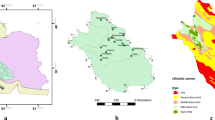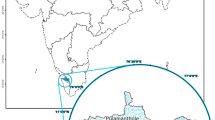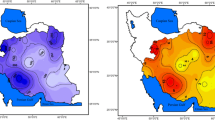Abstract
This study presents spatio-temporal analysis of droughts in one of the most drought prone region in India–western Rajasthan and develops drought intensity-area-frequency curves for the region. The meteorological drought conditions are analyzed using 6-month standardized precipitation index (SPI-6) estimated at spatial resolution of 0.5° × 0.5°. Spatio-temporal analysis of SPI-6 indicates increase in frequency of droughts at the central part of the region. The non-parametric Mann–Kendall test for seasonal trend analysis showed increase in number of grids under drought during the study period. Further, bivariate frequency analysis of drought characteristics—intensity and areal extent is carried out using copula methods. For modeling joint dependence between drought variables, three copula families namely Gumbel-Hougaard, Frank and Plackett copulas are evaluated. Based on goodness-of-fit as well as upper tail dependence tests, it is found that the Gumbel-Hougaard copula best represents the drought properties. The copula-based joint distribution is used to compute conditional return periods and drought intensity–area–frequency (I–A–F) curves. The I–A–F curves could be helpful in risk evaluation of droughts in the region.











Similar content being viewed by others
References
Andreadis KM, Clark EA, Wood AW, Hamlet AF, Lettenmaier DP (2005) Twentieth-century drought in the conterminous United States. J Hydrometeorol 6(6):985–1001
Capéraá P, Fougéres A-L, Genest C (1997) A non-parametric estimation procedure for bivariate extreme value copulas. Biometrika 84(3):567–577
Chowdhary A, Dandekar MM, Raut PS (1989) Variability in drought incidence over India—a statistical approach. Mausam 40:207–214
Drought report (2004) Drought—2002 Dept. of Agriculture and Cooperation, Ministry of Agriculture. Govt. of India, New Delhi
Frahm G, Junker M, Schimdt R (2005) Estimating the tail-dependence coefficient: properties and pitfalls. Insur Math Econ 37:80–100
Ganguli P, Janga Reddy M (2012) Risk assessment of droughts in Gujarat using bivariate copula. Water Resour Manag 26(11):301–3327
Genest C, Favre A-C (2007) Everything you always wanted to know about copula modeling but were afraid to ask. J Hydrol Eng 12(4):347–368
Genest C, Rémillard B, Beaudoin D (2009) Goodness-of-fit tests for copulas: a review and a power study. Insur Math Econ 44(2):199–213
Guhathakurta P (2003) Drought in districts of India during the recent all India normal monsoon years and its probability of occurrence. Mausam 54:542–545
Hamed KH, Rao AR (1998) A modified Mann–Kendall trend test for autocorrelated data. J Hydrol 204:182–196
Hirsch RM, Slack JR, Smith RA (1982) Techniques of trend analysis for monthly water quality data. Water Resour Res 18(1):107–121
Hisdal H, Tallaksen LM (2003) Estimation of regional meteorological and hydrological drought characteristics: a case study for Denmark. J Hydrol 281(3):230–247
Janga Reddy M, Ganguli P (2012) Application of copulas for derivation of drought severity–duration–frequency curves. Hydrol Process 26(11):1672–1685
Kendall MG (1975) Rank correlation methods. Griffin, London
Kim T-W, Valdés J-B (2002) Frequency and spatial characteristics of droughts in the Conchos River basin Mexico. Water Int 27(3):420–430
Kumar MN, Murthy CS, Sesha Sai MVR, Roy PS (2012) Spatiotemporal analysis of meteorological drought variability in the Indian region using standardized precipitation index. Meteorol Appl 19(2):256–264
Lee T, Modarres R, Ouarda TBMJ (2012) Data-based analysis of bivariate copula tail dependence for drought duration and severity. Hydrol Process. doi:10./hyp.9233
Loukas A, Vasiliades L (2004) Probabilistic analysis of drought spatiotemporal characteristics in Thessaly region, Greece. Nat Hazards Earth Syst Sci 4:719–731
Mall RK, Gupta A, Singh R, Singh RS, Rathore LS (2006) Water resources and climate change: an Indian perspective. Curr Sci 90:1610–1626
Mann HB (1945) Nonparametric tests against trend. Econometrica 13:245–259
McKee TB, Doesken NJ, Kleist J (1993) The relationship of drought frequency and duration to time scales. In: Proceedings of 8th International Conference Applied Climatology, Boston, MA, pp 179–184
Mir abbasi R, Fakheri-Fard A, Dinpashoh Y (2012) Bivariate drought frequency analysis using the copula method. Theor Appl Climatol 108:191–206
Mishra AK, Desai VR (2005) Spatial and temporal drought analysis in the Kansabati river basin, India. Int J River Basin Manag 3(1):31–41
NDMA Report (2010) National disaster management guidelines: management of drought. National Disaster Management Authority, Govt. of India. ISBN no 978-93-80440-08-8, New Delhi
Nelsen RB (2006) An introduction to copulas. Springer, New York
Nelsen RB, Quesada-Molina JJ, Rodríguez-Lallena JA, Úbeda-Flores M (2008) On the construction of copulas and quasi-copulas with given diagonal sections. Insur Math Econ 42(2):473–483
Obasi GOP (1994) WMO’s role in the international decade for natural disaster reduction. Bull Am Meteorol Soc 75(9):1655–1661
Pai DS, Sridhar L, Guhathakurta P, Hatwar HR (2010) Districtwise drought climatology of the southwest monsoon season over india based on standardized precipitation index. NCC Research Report no. 2/2010, National Climate Centre, IMD, Pune
Rajeevan M, Bhate J (2008) A high resolution daily gridded rainfall data set (1971–2005) for mesoscale meteorological studies. Research report no. 9/2008. National Climate Centre, IMD, Pune
RACP Report (2012) Rajasthan agriculture competitiveness project: social assessment and management framework. Technical report, Dept. Agriculture, Govt. Rajasthan
Sadri S, Burn DH (2012) Copula-based pooled frequency analysis of droughts in the Canadian Prairies. J Hydrol Eng. doi:10.1061/(ASCE)HE.1943-5584.0000603
Santos JF, Pulido-Calvo I, Portela M (2010) Spatial and temporal variability of droughts in Portugal. Water Resour Res 46:W03503
Sen PK (1968) Estimates of the regression coefficient based on Kendall’s tau. J Am Stat Assoc 63(324):1379–1389
Shiau JT (2006) Fitting drought duration and severity with two-dimensional copulas. Water Resour Manag 20:795–815
Sinha Ray KC, Shewale MP (2001) Probability of occurrence of drought in various subdivisions of India. Mausam 52:541–546
Sklar A (1959) Functions de repartition a n dimensions et leurs marges. Publ Inst Stat Univ Paris 8:229–231
Song S, Singh VP (2010) Frequency analysis of droughts using the Plackett copula and parameter estimation by genetic algorithm. Stochast Environ Res Risk Assess 24(5):783–805
Svoboda M, Lecomte D, Hayes M, Heim R, Gleason K, Angel J, Rippey B, Tinker R, Palecki M, Stooksbury D, Miskus D, Stephens S (2002) The drought monitor. Bull Am Meteorol Soc 83:1181–1190
Tallaksen LM, Stahl K, Wong G (2011) Space-time characteristics of large-scale droughts in Europe derived from streamflow observations and WATCH multi-model simulations. Technical report no. 48, University of Oslo
WMO Report (2006) Drought monitoring and early warning: concepts, progress and future challenges. WMO report no. 1006, World Meteorological Organization
Author information
Authors and Affiliations
Corresponding author
Appendix
Appendix
1.1 Mann–Kendall test
The most popular non-parametric test to detect trends in hydroclimatic variables is the Mann–Kendall (MK) test (Mann 1945; Kendall 1975), which evaluates randomness of the data against trend. The null hypothesis\( H_{0} \) for this test assumes that no temporal trend exists, and the alternate hypothesis H 1 assumes that a significant temporal trend (upward or downward) exists.
The test statistic Z MK is computed as,
where S is defined by,
where x j and x k are the data points in time periods j and k (\( j > k \)) respectively, and n is number of observed data points. According to Kendall (1975) for n ≥ 10, the test statistic S is approximately normally distributed with the mean of E(S) = 0, and the variance of,
where g is the number of tied groups and t i is the number of data points in the i-th group. Later, it was also noted that a correction factor (\( \eta \)) should be incorporated in Var(S) to correct the influence of serial correlation on the test (Hamed and Rao 1998). The modified variance Var *(S) is given by,
where \( \rho_{S} \left( i \right) \) is the autocorrelation corresponding to ith lag of ranks of the observations (i = 1, 2,…up to \( \left\lfloor {{n \mathord{\left/ {\vphantom {n 4}} \right. \kern-0pt} 4}} \right\rfloor \) lags); \( \rho_{\alpha }^{*} \) is confidence interval of auto-correlation at significance level of α which is approximately \( \pm \frac{2}{\sqrt n } \) at α = 0.05; \( 1\left\{ \Uptheta \right\} \) is a logical indicator function of set \( \Uptheta \) and taking the value of either 0 (if \( \Uptheta \) is false) or 1 (if \( \Uptheta \) is true). Hence, the modified MK test statistics is given as
For seasonal Mann–Kendall test, the statistics S i for each time period are summed to form the overall test statistic S seasonal and \( Var^{*} \left( {S_{i} } \right) \) is computed across m season by summing individual seasonal variance (Hirsch et al. 1982)
Corresponding test statistic ZMK is computed using Eq. 17.
In a two-tailed test for trend at significance level of α, \( H_{0} \) should be rejected, if \( \left| {Z_{MK}^{*} } \right| > Z_{critical} \) (i.e., accept alternate hypothesis that significant trend exists in the time series), where \( Z_{critical} \; = \;Z_{{{{1 - \alpha } \mathord{\left/ {\vphantom {{1 - \alpha } 2}} \right. \kern-0pt} 2}}} \) at significance level α. At α = 0.05 and 0.10, the values of standard normal variate \( Z_{{{{1 - \alpha } \mathord{\left/ {\vphantom {{1 - \alpha } 2}} \right. \kern-0pt} 2}}} \) are 1.96 and 1.64 respectively. Hence in the time series (at significance level of α), an upward trend exits if \( Z_{MK}^{*} \) > \( Z_{critical} \), and decreasing trend exists if \( Z_{MK}^{*} \) < \( - Z_{critical} \).
1.2 Sen’s slope estimator
If a trend exists in a time series then the slope (change per unit time) can be estimated by a simple nonparametric procedure developed by Sen (1968). The method to estimate Sen’s slope estimator is described below.
-
The slope estimates (say b i ) of N pairs of data are first computed by,
where x j and x k are the data points in time periods j and k (\( j > k \)) respectively. Here, if there are n values of data in the time series, it results in as many as N = nC2 number of slope estimates (i.e., b i values).
-
Then, the Sen’s slope estimator (b np ) is the median of those N number of b i values:
Rights and permissions
About this article
Cite this article
Reddy, M.J., Ganguli, P. Spatio-temporal analysis and derivation of copula-based intensity–area–frequency curves for droughts in western Rajasthan (India). Stoch Environ Res Risk Assess 27, 1975–1989 (2013). https://doi.org/10.1007/s00477-013-0732-z
Published:
Issue Date:
DOI: https://doi.org/10.1007/s00477-013-0732-z




